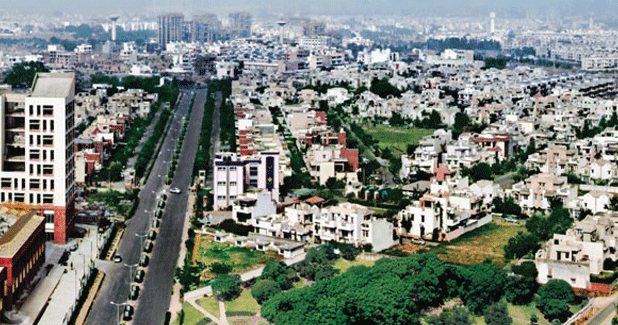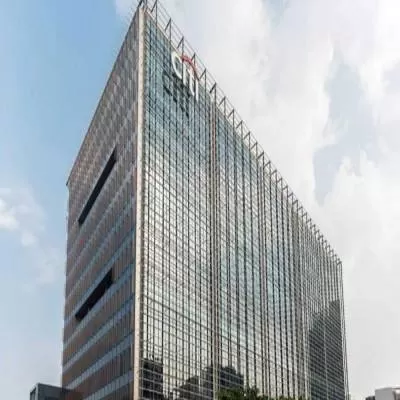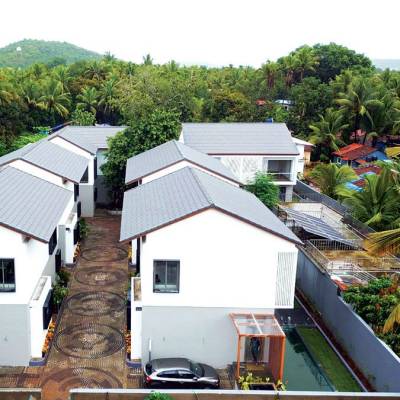- Home
- Real Estate
- The Real Show 2015

The Real Show 2015
The sentiment on Indian real estate among both domestic and international investors has improved in recent times following the election of a new government and upturn in consumer demand, says the Emerging Trends in Real Estate® Asia Pacific 2015 report, published jointly by the Urban Land Institute and PricewaterhouseCoopers. And according to KPMG´s estimate, the sector is expected to grow by 30 per cent by 2015 while the market is expected to touch $180 billion by 2020. P Sahel, Vice Chairman, Lotus Greens, shares: ¨Over the next five years, the Indian real-estate market is expected to grow at a CAGR of 20 per cent, driven by 18-19 per cent growth in residential real estate, 55-60 per cent in retail real estate, and 20-22 per cent in commercial real estate.¨
Home truths
With regard to residential real estate, Anuj Puri, Chairman & Country Head, JLL India, says, ¨In 2015, developers will become more earnest about right-sizing and right-pricing their offerings.¨ He is certain that smaller, yet better-designed and more efficient homes will define this market, and selective corrections in some overpriced cities will enable faster sales for stagnated supply of larger configurations. Townships will become more prevalent, and the supply of luxury homes will moderate to align with the slow demand dynamics. ¨A large portion of total unsold residential inventory is in under-construction projects, while completed projects have only moderate vacancy,¨ says Puri, adding that home buyers will benefit from reduced borrowing rates in 2015 along with increased developer focus on affordable homes, largely stable prices, and better employment and income prospects.
Affordable quotient
Affordable housing is expected to be the flavour of the year. While every city does have its own affordability threshold and benchmark, Puri believes that affordable housing is in itself not a difficult format to deliver. He says, ¨The challenge for many developers will be to align this format with their existing brand image.¨ To this, Rajesh Prajapati, Managing Director, Prajapati Constructions, adds, ¨The government must intervene in keeping land prices competitive if it wants housing to be within the reach of the people. Banks should also be encouraged to cut down interest rates. And Mohit Goel, CEO, Omaxe, says, ¨The coming times will throw up more opportunities and we are geared up to meet the challenges that come our way.¨
Retail´s reality
In 2014, the retail real-estate sector was one of the biggest casualties to market conditions that increasingly favoured the online retail community, says Puri. ¨Strata-sold, poorly managed, badly located retail properties lost lustre as more retailers chose to avoid them,¨ he points out. ¨The measures that a handful of mall developers have undertaken include a revamped tenant mix, adoption of the mixed-use format and delivering theme-based shopping experiences.¨ These practices are common overseas and Indian retail malls will be seen adapting to them more rapidly in 2015.
Office turnaround
Development of commercial realty is relative to the performance of the retail sector, which according to Neeraj Gulati, Managing Director, Assotech Realty, ¨is expected to gain momentum in the second half of 2015.¨ Sharing JLLs forecast, Puri says, ¨Although office real-estate prices failed to recover from the after-effects of the financial crisis up to late 2014, we did see the beginning of a gradual turnaround after the elections that is reflecting in year-end office market leases. The trend of moderate-to-healthy leasing activity will continue in 2015.¨
Keys to grow
As for the hospitality sector, a recent report by Cushman & Wakefield reveals that Delhi-NCR and Mumbai are expected to see an addition of 6,798 rooms by the end of 2015. Over 11,000 keys and 16,000 keys are expected to enter the market between 2014 and 2018 in Mumbai and Delhi-NCR, respectively. While Puri expects to see increased interest in the sector compared to the previous year, PR Srinivas, Director, Hospitality India, Cushman & Wakefield, says, ¨The stability of the global market and strength of the rupee will be critical in assuring a healthier performance by these two gateway markets of India.¨
The policy level
Indeed, 2015 brings new hope, with the real-estate sector looking at policy and budget reforms. Sahel says, ¨Incorporation of the Land and Real-Estate Regulatory Bill, a single-window clearance system, widening of external commercial borrowing (ECB) and granting infrastructure status will further boost the sector.¨ Confident that the government´s steps will show results from the second quarter, Goel says, ¨The Budget will play a crucial role in defining the vision for the economy. The ´Housing for All by 2022´ mission along with the policy on smart cities augurs well.¨ Much headway in the form of REITS, FDI norms, the Real Estate Regulation Bill (RERA) and ´Housing for All´ has already been made in several policy reforms during the second half of 2014. M Murali, Managing Director, Shriram Properties, adds to the list: ¨Welcome tax reforms and GST may happen at any time. Also, erasing tax barriers between states and bringing in a single tax will enable a common national market for goods and delivery of services.¨
Here, Puri highlights two key aspects: REIT and RERA. While REIT got a green signal in 2014, he says, ¨The listing of new REITs will be slow and steady, although it will succeed over the longer term.¨ As for the alternate mechanism for redress, ¨It is unclear whether RERA will finally be ratified as a law in 2015 but the fact that hard discussions are happening is indicative of the new government´s determination to make it a reality.¨
Cities in focus
With improvement in the economic situation, Pune, Chennai, Hyderabad and Kolkata are expecting to start attracting sizeable investments along with the top three metros of Mumbai, NCR and Bengaluru. ¨This will be a notable change from dynamics seen in the past, wherein only these three cities ruled the roost,¨ says Puri. ¨With this, Grade A commercial properties in Tier-II and Tier-III cities will appear on the radar of investors though a full-on focus on these opportunities will probably not take place in 2015.¨
Gulati sees potential in the mid-housing segment and high income group segment, especially in the NCR and Tier-II and Tier-III cities. With similar expectations, Goel says, ¨We have ambitious plans for cities including Lucknow, New Chandigarh, Faridabad and Indore, to name a few, besides a project in NCR. We are confident of this segment that we operate in; debt levels, too, remain comfortable.¨
Growth contributors
New and emerging real-estate corridors - such as Sohna, Yamuna Expressway and Dwarka-Gurgaon Expressway in NCR, Ulwe and Karanjade in Mumbai and Hennar Road in Bengaluru - are already attracting projects, buyers and investors owing to the planned infrastructure and speedy connectivity in these locations. Gulati shares, ¨Some of these destinations are fast emerging as attractive for standalone developments, group housing and commercial complexes. The areas likely to report significant growth going forward are Rewari and Dharuhera on the lines of the smart cities proposed by the NDA Government.¨ Sahel adds, ¨The Delhi-Mumbai Industrial Corridor (DMIC) is one example of the rise in the infrastructure industry, which will cover most of the industrial zones with the parallel development of smart cities and creation of a complete logistics network.¨
Prajapati sees the focus shifting to Navi Mumbai, where a slew of infrastructure development projects are planned and underway, which will have a direct impact on real-estate prices in Mumbai and the MMR region. ¨Enormous interest is being generated with Phase-I of the Rs 14,500-crore new international airport slated to be operational by 2018, and work on the Mumbai Trans Harbour Link (MTHL) or the Sewree-Uran sea link expected to commence soon.¨
In conclusion, Shishir Baijal, Chairman & Managing Director, Knight Frank India, says, ¨As we move into 2015, one of the crucial tasks for the current government will be to transform the chaotic image of Indian urbanisation. The better way to do it will be to capitalise on the buzz around the creation of smart cities. In fact, work has already begun on two such concepts: The Gujarat International Finance Tec-City, on the outskirts of Ahmedabad, and Dholera, an industrial hub on the DMIC. This coupled with REIT has generated excitement and we look forward to these developments to usher in change for the real-estate sector, which has been reeling under pressure.¨
Quick Bytes
- Real estate sector expected to grow by
- 30 per cent in 2015.
- Residential: Developers to focus more on right-sizing and right-pricing.
- Retail: Revamped tenant mix, mixed-use format and theme-based malls to be adopted.
- Commercial: Trend of moderate-to-healthy
- leasing activity to continue.
- Hospitality: Delhi-NCR, Mumbai expected to see addition of 6,798 rooms by 2015-end.
Political will with spine, says CREDAI
At the threshold of the New Year, Lalit Kumar Jain, Chairman, CREDAI, and Chairman & Managing Director, Kumar Urban Development, calls for ¨political will with spine¨ to bring about real-estate reforms and revive the crisis-ridden industry to rejuvenate the economy. Lauding Prime Minister Narendra Modi and his Cabinet colleagues for their ideas, Jain says, ¨We need fast implementation; else, there is a risk of losing steam. The input cost on account of labour in the construction industry has increased. The government needs to regulate steel and cement prices just as the power regulators monitor tariff. Also, high lending rate by banks has hit realty severely. We anticipate that land, administrative tax and banking reforms will be executed without further delay.¨ Appreciating the policies on smart cities and ¨Housing for All´, he points out, ¨Smart cities require smart policies.¨
- Real Estate
- KPMG
- P Sahel
- Lotus Greens
- CAGR
- Anuj Puri
- JLL India
- Affordable
- Rajesh Prajapati
- Prajapati Constructions
- Mohit Goel
- Omaxe
- Neeraj Gulati
- Assotech Realty
- Cushman
- Wakefield
- PR Srinivas
- ECB
- Real Estate Regulation Bill
- RERA
- REITS
- FDI
- M Murali
- Shriram Properties
- GST
- Sohna
- Delhi-Mumbai Industrial Corridor
- DMIC
- Infrastructure
- MMR
- Mumbai Trans Harbour Link
- MTHL,
With new policy measures and announcements over the past few months, the real-estate segment is positive about the New Year. The sentiment on Indian real estate among both domestic and international investors has improved in recent times following the election of a new government and upturn in consumer demand, says the Emerging Trends in Real Estate® Asia Pacific 2015 report, published jointly by the Urban Land Institute and PricewaterhouseCoopers. And according to KPMG´s estimate, the sector is expected to grow by 30 per cent by 2015 while the market is expected to touch $180 billion by 2020. P Sahel, Vice Chairman, Lotus Greens, shares: ¨Over the next five years, the Indian real-estate market is expected to grow at a CAGR of 20 per cent, driven by 18-19 per cent growth in residential real estate, 55-60 per cent in retail real estate, and 20-22 per cent in commercial real estate.¨ Home truths With regard to residential real estate, Anuj Puri, Chairman & Country Head, JLL India, says, ¨In 2015, developers will become more earnest about right-sizing and right-pricing their offerings.¨ He is certain that smaller, yet better-designed and more efficient homes will define this market, and selective corrections in some overpriced cities will enable faster sales for stagnated supply of larger configurations. Townships will become more prevalent, and the supply of luxury homes will moderate to align with the slow demand dynamics. ¨A large portion of total unsold residential inventory is in under-construction projects, while completed projects have only moderate vacancy,¨ says Puri, adding that home buyers will benefit from reduced borrowing rates in 2015 along with increased developer focus on affordable homes, largely stable prices, and better employment and income prospects. Affordable quotient Affordable housing is expected to be the flavour of the year. While every city does have its own affordability threshold and benchmark, Puri believes that affordable housing is in itself not a difficult format to deliver. He says, ¨The challenge for many developers will be to align this format with their existing brand image.¨ To this, Rajesh Prajapati, Managing Director, Prajapati Constructions, adds, ¨The government must intervene in keeping land prices competitive if it wants housing to be within the reach of the people. Banks should also be encouraged to cut down interest rates. And Mohit Goel, CEO, Omaxe, says, ¨The coming times will throw up more opportunities and we are geared up to meet the challenges that come our way.¨ Retail´s reality In 2014, the retail real-estate sector was one of the biggest casualties to market conditions that increasingly favoured the online retail community, says Puri. ¨Strata-sold, poorly managed, badly located retail properties lost lustre as more retailers chose to avoid them,¨ he points out. ¨The measures that a handful of mall developers have undertaken include a revamped tenant mix, adoption of the mixed-use format and delivering theme-based shopping experiences.¨ These practices are common overseas and Indian retail malls will be seen adapting to them more rapidly in 2015. Office turnaround Development of commercial realty is relative to the performance of the retail sector, which according to Neeraj Gulati, Managing Director, Assotech Realty, ¨is expected to gain momentum in the second half of 2015.¨ Sharing JLLs forecast, Puri says, ¨Although office real-estate prices failed to recover from the after-effects of the financial crisis up to late 2014, we did see the beginning of a gradual turnaround after the elections that is reflecting in year-end office market leases. The trend of moderate-to-healthy leasing activity will continue in 2015.¨ Keys to grow As for the hospitality sector, a recent report by Cushman & Wakefield reveals that Delhi-NCR and Mumbai are expected to see an addition of 6,798 rooms by the end of 2015. Over 11,000 keys and 16,000 keys are expected to enter the market between 2014 and 2018 in Mumbai and Delhi-NCR, respectively. While Puri expects to see increased interest in the sector compared to the previous year, PR Srinivas, Director, Hospitality India, Cushman & Wakefield, says, ¨The stability of the global market and strength of the rupee will be critical in assuring a healthier performance by these two gateway markets of India.¨ The policy level Indeed, 2015 brings new hope, with the real-estate sector looking at policy and budget reforms. Sahel says, ¨Incorporation of the Land and Real-Estate Regulatory Bill, a single-window clearance system, widening of external commercial borrowing (ECB) and granting infrastructure status will further boost the sector.¨ Confident that the government´s steps will show results from the second quarter, Goel says, ¨The Budget will play a crucial role in defining the vision for the economy. The ´Housing for All by 2022´ mission along with the policy on smart cities augurs well.¨ Much headway in the form of REITS, FDI norms, the Real Estate Regulation Bill (RERA) and ´Housing for All´ has already been made in several policy reforms during the second half of 2014. M Murali, Managing Director, Shriram Properties, adds to the list: ¨Welcome tax reforms and GST may happen at any time. Also, erasing tax barriers between states and bringing in a single tax will enable a common national market for goods and delivery of services.¨ Here, Puri highlights two key aspects: REIT and RERA. While REIT got a green signal in 2014, he says, ¨The listing of new REITs will be slow and steady, although it will succeed over the longer term.¨ As for the alternate mechanism for redress, ¨It is unclear whether RERA will finally be ratified as a law in 2015 but the fact that hard discussions are happening is indicative of the new government´s determination to make it a reality.¨ Cities in focus With improvement in the economic situation, Pune, Chennai, Hyderabad and Kolkata are expecting to start attracting sizeable investments along with the top three metros of Mumbai, NCR and Bengaluru. ¨This will be a notable change from dynamics seen in the past, wherein only these three cities ruled the roost,¨ says Puri. ¨With this, Grade A commercial properties in Tier-II and Tier-III cities will appear on the radar of investors though a full-on focus on these opportunities will probably not take place in 2015.¨ Gulati sees potential in the mid-housing segment and high income group segment, especially in the NCR and Tier-II and Tier-III cities. With similar expectations, Goel says, ¨We have ambitious plans for cities including Lucknow, New Chandigarh, Faridabad and Indore, to name a few, besides a project in NCR. We are confident of this segment that we operate in; debt levels, too, remain comfortable.¨ Growth contributors New and emerging real-estate corridors - such as Sohna, Yamuna Expressway and Dwarka-Gurgaon Expressway in NCR, Ulwe and Karanjade in Mumbai and Hennar Road in Bengaluru - are already attracting projects, buyers and investors owing to the planned infrastructure and speedy connectivity in these locations. Gulati shares, ¨Some of these destinations are fast emerging as attractive for standalone developments, group housing and commercial complexes. The areas likely to report significant growth going forward are Rewari and Dharuhera on the lines of the smart cities proposed by the NDA Government.¨ Sahel adds, ¨The Delhi-Mumbai Industrial Corridor (DMIC) is one example of the rise in the infrastructure industry, which will cover most of the industrial zones with the parallel development of smart cities and creation of a complete logistics network.¨ Prajapati sees the focus shifting to Navi Mumbai, where a slew of infrastructure development projects are planned and underway, which will have a direct impact on real-estate prices in Mumbai and the MMR region. ¨Enormous interest is being generated with Phase-I of the Rs 14,500-crore new international airport slated to be operational by 2018, and work on the Mumbai Trans Harbour Link (MTHL) or the Sewree-Uran sea link expected to commence soon.¨ In conclusion, Shishir Baijal, Chairman & Managing Director, Knight Frank India, says, ¨As we move into 2015, one of the crucial tasks for the current government will be to transform the chaotic image of Indian urbanisation. The better way to do it will be to capitalise on the buzz around the creation of smart cities. In fact, work has already begun on two such concepts: The Gujarat International Finance Tec-City, on the outskirts of Ahmedabad, and Dholera, an industrial hub on the DMIC. This coupled with REIT has generated excitement and we look forward to these developments to usher in change for the real-estate sector, which has been reeling under pressure.¨ Quick Bytes Real estate sector expected to grow by 30 per cent in 2015. Residential: Developers to focus more on right-sizing and right-pricing. Retail: Revamped tenant mix, mixed-use format and theme-based malls to be adopted. Commercial: Trend of moderate-to-healthy leasing activity to continue. Hospitality: Delhi-NCR, Mumbai expected to see addition of 6,798 rooms by 2015-end. Political will with spine, says CREDAI At the threshold of the New Year, Lalit Kumar Jain, Chairman, CREDAI, and Chairman & Managing Director, Kumar Urban Development, calls for ¨political will with spine¨ to bring about real-estate reforms and revive the crisis-ridden industry to rejuvenate the economy. Lauding Prime Minister Narendra Modi and his Cabinet colleagues for their ideas, Jain says, ¨We need fast implementation; else, there is a risk of losing steam. The input cost on account of labour in the construction industry has increased. The government needs to regulate steel and cement prices just as the power regulators monitor tariff. Also, high lending rate by banks has hit realty severely. We anticipate that land, administrative tax and banking reforms will be executed without further delay.¨ Appreciating the policies on smart cities and ¨Housing for All´, he points out, ¨Smart cities require smart policies.¨
























